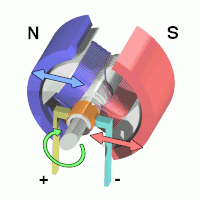
Photo from wikipedia
Abstract An efficient and explicit topology optimization approach is initially proposed for eigenfrequencies of a rotating thin plate in this study. First of all, an accurate dynamic model of the… Click to show full abstract
Abstract An efficient and explicit topology optimization approach is initially proposed for eigenfrequencies of a rotating thin plate in this study. First of all, an accurate dynamic model of the rotating thin plate is established via the thin plate elements of the absolute nodal coordinate formulation (ANCF). When performing the modal characteristic analysis of the rotating thin plate at a prescribed angular velocity, the linear perturbation analysis is employed, during which the coupling between the membrane and bending deformations is considered. The coupling term makes the dynamic model established in the study more accurate than conventional models, especially in the case of large deformations. Then, the moving morphable components (MMC) are used to describe the topology of the plate. In the frame of MMC-based topology optimization, explicit geometrical parameters, positions, and orientations of the components are taken as the design variables so that the total number of the design variables can be greatly reduced. For the topology optimization, the sensitivities of a simple eigenfrequency and multiply repeated eigenfrequencies with respect to a design variable are analytically derived. During the optimization, in order to remove the localized modes in the low-density areas, the mass and stiffness matrices of the thin plate elements of ANCF are carefully penalized. Finally, four numerical examples are presented to validate the proposed topology optimization approach and to demonstrate its effectiveness for two objectives, i.e., maximizing either the first eigenfrequency or the gap between two consecutive eigenfrequencies of a rotating thin plate.
Journal Title: Journal of Sound and Vibration
Year Published: 2019
Link to full text (if available)
Share on Social Media: Sign Up to like & get
recommendations!